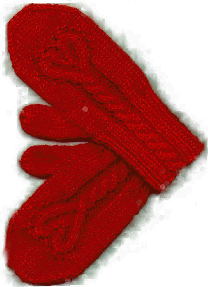

Knitting Tips - How do I stop biasing?
What is happening is that extra twist in the yarn is influencing the knitting, and pushing it slantwise.
Here are some hints to help the problem.
1) Knit a strand of sewing thread or another very thin, well spun yarn along with the chenille. If it is in a matching color, it won't show at all. If it contrasts, think of it as a design element. This also helps prevent another frequent problem with chenille--worming (when loose loops of yarn pull out of the fabric and twist back on themselves, making little tails).
2) Pick a pattern stitch that combines knit and purl stitches like seed stitch or moss stitch. Knits and purls together will help keep it from slanting. The pattern stitch used in the chinese waves dishcloth in the Free Patterns section of this web site is also a good stitch to stabilize the fabric. This pattern stitch is shown in the boarder on the left edge of the screen.
3) Use a smaller needle size. Knitting more tightly will help stabilize the fabric and stop biasing.
4) Do not knit seamless, circular garments with a yarn that has this problem. Knitting the garment pieces separately, and then seaming them will help to keep the fabric from biasing.
5) For purses, pillow covers, etc., you may be able to add a backing that will stabilize the fabric. Depending on the type of fiber that the yarn is made out of, you could use fusible interfacing (extra heavy weight, if you want it stiff) to stabilize the fabric. You can get this at a fabric store, but you must iron it on with a hot iron to fuse it to your knitting. This will only work if the yarn is made out of cotton, linen or wool. Other fibers will melt or be destroyed by the heat, so if there is any nylon, acrylic, or polyester in your yarn, you will probably want to avoid this.
Questions or suggestions?? Contact us
All text and images copyright © 1998, 2002 Margaret K.K. Radcliffe
Most knitting will maintain its rectangular shape when you take it off the needles. When the square or rectangle you've knitted develops a pronounced slant, and turns into a trapezoid, the problem you are having is called "biasing." It's a frequent complaint with chenille yarns, with cottons (especially when the yarn is a "single" rather than a plied yarn) and sometimes even with wool.
![]()
![]()
![]()
![]()
![]()
![]()
![]()
![]()
![]()
![]()
![]()
![]()